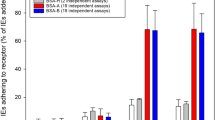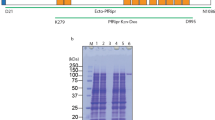Abstract
The late blood stages of the human malaria parasite, Plasmodium falciparum, carry a major surface antigen, p190, of molecular weight (Mr) 190,000 (ref. 1). This antigenically variable protein1–3 is actively processed, first as the parasite matures and again when it is released into the blood stream and invades a new erythrocyte to initiate a cycle of growth1. It elicits a strong immune response in man; all tested adult sera from endemic areas have antibodies against this protein1. Our evidence indicates that purified p 190 can alter the course of parasitaemia in monkeys with falciparum malaria. We have also succeeded in cloning part of the gene for p190 and expressing it in Escherichia coli. To this end we have developed a new technique, antibody select, which greatly simplifies final identification of expressing clones.
This is a preview of subscription content, access via your institution
Access options
Subscribe to this journal
Receive 51 print issues and online access
$199.00 per year
only $3.90 per issue
Buy this article
- Purchase on Springer Link
- Instant access to full article PDF
Prices may be subject to local taxes which are calculated during checkout
Similar content being viewed by others
References
Hall, R. et al. Molec. biochem. Parasit. 11, 61–80 (1984).
Hall, R. et al. Molec. biochem. Parasit. 7, 247–265 (1983).
McBride, J. S., Walliker, D. & Morgan, G. Science 217, 254–257 (1982).
Holder, A. A. & Freeman, R. R. J. exp. Med. 156, 1528–1538 (1981).
Holder, A. A. & Freeman, R. R. Nature 294, 361–364 (1981).
Boyle, D. B., Newbold, C. I., Smith, C. C. & Brown, K. N. Infect. Immun. 38, 94–102 (1982).
Holder, A., Freeman, R. R. & Newbold, C. I. Molec. biochem. Parasit. 9, 191–196 (1983).
Epstein, N. et al. J. Immun. 127, 212–217 (1981).
Deans, J. A. et al. Clin. exp. Immun. 49, 297–309 (1983).
Thaithong, S. & Beale, G. H. Trans. R. Soc. trop. Med. Hyg. 75, 271–273 (1981).
Thaithong, S. et al. Trans. R. Soc. trop. Med. Hyg. 78, 242–245 (1984).
Ozaki, L. S. et al. Cell 34, 815–822 (1983).
Coppel, R. L. et al. Nature 306, 751–756 (1983).
Young, R. A. & Davis, R. W. Proc. natn. Acad. Sci. U.S.A. 80, 1194–1198 (1983).
Kemp, D. J. et al. Proc. Natn. Acad. Sci. U.S.A. 80, 3787–3791 (1983).
Hyde, J. E. et al. Molec. biochem. Parasit. 10, 269–285 (1984).
Zabin, I. & Fowler, A. V. in The Operon (eds Miller, J. H. & Reznikoff, W. S.) 89–121 (Cold Spring Harbor, New York, 1978).
Maniatis, T., Fritsch, E. F. & Sambrook, J. in Molecular Cloning, 329–349 (Cold Spring Harbor, New York, 1982).
MacKay, I. et al. Proc. natn. Acad. Sci. U.S.A. 78, 4510–4514 (1981).
Hyde, J. E., Zolg, J. W. & Scaife, J. G. Molec. biochem. Parasit. 4, 283–290 (1981).
Rosario, V. Science 212, 1037–1038 (1981).
Lis, J. T., Prestidge, L. & Hogness, D. S. Cell 14, 901–919 (1978).
Langsley, G., Hyde, J. E., Goman, M. & Scaife, J. G. Nucleic Acids Res. 11, 8703–8717 (1983).
Jurg, J., Sippel, A. E., Crez, M. & Schutz, G. Proc. natn. Acad. Sci. U.S.A. 77, 5759–5783 (1980).
Hagenbuchle, O., Borez, R. & Young, R. A. Cell 21, 179–187 (1980).
Mostov, K. E., Friedlander, M. & Blobel, G. Nature 308, 37–43 (1984).
Chandler, H. M. et al. J. immun. Meth. 53, 187–194 (1982).
Stanley, K. K. Nucleic Acids Res. 11, 4077–4092 (1983).
Towbin, H., Staehelin, T. & Gordon, J. Proc. natn. Acad. Sci. U.S.A. 76, 4350–4354 (1979).
Laemmli, U. K. Nature 227, 680–685 (1970).
Hope, I. A. et al. Nature 308, 191–194 (1984).
Sanger, F., Nicklen, S. & Coulson, A. R. Proc. natn. Acad. Sci. U.S.A. 74, 5463–5467 (1977).
Messing, J. & Vieira, J. Gene 19, 269–276 (1982).
Author information
Authors and Affiliations
Rights and permissions
About this article
Cite this article
Hall, R., Hyde, J., Goman, M. et al. Major surface antigen gene of a human malaria parasite cloned and expressed in bacteria. Nature 311, 379–382 (1984). https://doi.org/10.1038/311379a0
Received:
Accepted:
Issue Date:
DOI: https://doi.org/10.1038/311379a0
This article is cited by
-
Plasmodium post-genomics: better the bug you know?
Nature Reviews Microbiology (2006)
-
A superfamily of variant genes encoded in the subtelomeric region of Plasmodium vivax
Nature (2001)
-
A principal target of human immunity to malaria identified by molecular population genetic and immunological analyses
Nature Medicine (2000)
-
From genomics to vaccines: Malaria as a model system
Nature Medicine (1998)
-
Malaria vaccine
Experientia (1991)
Comments
By submitting a comment you agree to abide by our Terms and Community Guidelines. If you find something abusive or that does not comply with our terms or guidelines please flag it as inappropriate.



